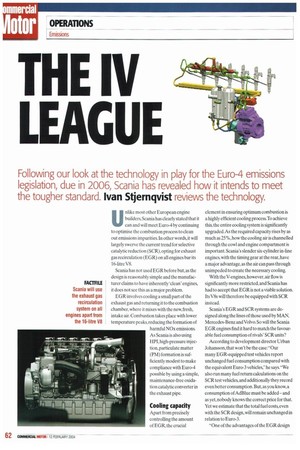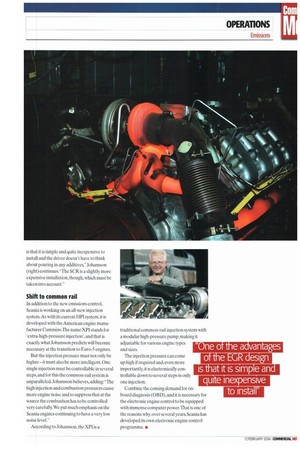THE IV LEAGUE
Page 62

Page 63

If you've noticed an error in this article please click here to report it so we can fix it.
Following our look at the technology in play for the Euro-4 emissions
legislation, due in 2006, Scania has revealed how it intends to meet the tougher standard. Ivan Stjernqvist reviews the technology.
Unlike most other European engine builders, Scania has clearly stated that it can and will meet Euro-4 by continuing to optimise the combustion process to clean out emissions impurities. In other words, it will largely swerve the current trend for selective catalytic reduction (SCR), opting for exhaust gas recirculation (EGR) on all engines bar its 16-litre V8.
Scania has not used EGR before but,as the design is reasonably simple and the manufacturer claims to have inherently 'clean' engines, it does not see this as a major problem.
EGR involves cooling a small part of the exhaust gas and returning it to the combustion chamber, where it mixes with the new, fresh, intake air. Combustion takes place with lower temperature peaks, reducing the formation of harmful NOx emissions. As Scania is also using HP!, high-pressure injection,particulate matter (PM) formation is sufficiently modest to make compliance with Euro-4 possible by using a simple, maintenance-free oxidation catalytic converter in the exhaust pipe.
Cooling capacity
Apart from precisely controlling the amount of EGR, the crucial element in ensuring optimum combustion is a highly efficient cooling process.To achieve this, the entire cooling system is significantly upgraded.As the required capacity rises by as much as 25%, how the cooling air is channelled through the cowl and engine compartment is important. Scania's slender six-cylinder in-line engines, with the timing gear at the rear, have a major advantage, as the air can pass through unimpeded to create the necessary cooling.
With the V-engines,however,air flow is significantly more restricted, and Scania has had to accept that FOR is not a viable solution. Its V8s will therefore be equipped with SCR instead.
Scania's EGR and SCR systems are designed along the lines of those used by MAN, Mercedes-Benz and Volvo. So will the Scania EGR engines find it hard to match the favourable fuel consumption of rivals' SCR units?
According to development director Urban Johansson, that won't be the case:"Our many EGR-equipped test vehicles report unchanged fuel consumption compared with the equivalent Euro-3 vehicles," he says."We also run many fuel return calculations on the SCR test vehicles, and additionally they record even better consumption. But, as you know, a consumption of AdBlue must be added—and as yet,nobody knows the correct price for that. Yet we estimate that the total fuel costs, even with the SCR design, will remain unchanged in relation to Euro-3.
"One of the advantages of the EGR design is that it is simple and quite inexpensive to install and the driver doesn't have to think about pouring in any additives," Johansson (right) continues. "The SCR is a slightly more expensive installation,though, which must be taken into account."
Shift to common rail
In addition to the new emissions control, Scania is working on an all-new injection system.As with its current HPI system, it is developed with the American engine manufacturer Cummins.The name XPI stands for 'extra-high-pressure injection', and that is exactly what Johansson predicts will become necessary at the transition to Euro-S engines.
But the injection pressure must not only he higher— it must also be more intelligent. One single injection must be controllable in several steps, and for this the common-rail system is unparalleled. Johansson believes, adding: "The high injection and combustion pressures cause more engine noise and to suppress that at the source the combustion has to be controlled very careful ly.We put much emphasis on the Scania engines continuing to have a very low noise level."
According to Johansson, the XPI is a traditional common-rail injection system with a modular high-pressure pump, making it adjustable for various engine types and sizes.
The injection pressure can come up high if required and, even more importantly, it is electronically controllable down to several steps in only one injection.
Combine the coming demand for onboard diagnosis (OBD), and it is necessary for the electronic engine control to be equipped with immense computer power.That is one of the reasons why, over several years, Scania has developed its own electronic engine control programme. •






























































































































































































